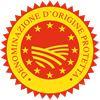Description
Pecorino Sardo PDO is a semi-cooked cheese produced with whole sheep’s milk. It is produced in two distinct typologies: Dolce (sweet, aged 20-60 days) and Maturo (mature, aged over 60 days).
Production Area
The production area of Pecorino Sardo PDO is within the entire territory of the Sardinia region.
Production Method
The whole sheep’s milk, originating exclusively from the production area, can be thermised or pasteurised. It is then curdled with calf rennet at 35-38 °C for 35-40 minutes. Once the curd is obtained, it is broken until the grains are the size of a walnut for the Pecorino Sardo PDO Dolce, and the size of a corn kernel for the Maturo variety. It is then semi-cooked, pressed, dry salted or salted in brine, and ripened. The length of the ripening period is different for the two typologies: 20 to 60 days for the pecorino Dolce, and no less than 60 days for the pecorino Maturo. After ripening, the cheeses are smoked naturally.
Appearance and Flavour
Pecorino Sardo PDO has a cylindrical shape and flat surfaces, with a variable weight of 1 to 2.3 kg for the Dolce variety and 1.7 to 4 kg for the Maturo variety. The colour of the cheese ranges from white to straw-yellow, depending on how mature it is. The consistency is firm with a few eyes, and soft for the Dolce variety. The rind is smooth and thin for the Dolce variety, with a white to straw-yellow colour, while that of the Maturo variety is thicker and has a more brownish colour. The Dolce variety is sweet-aromatic or slightly sour, while the pecorino Maturo is stronger and pleasantly piquant.
History
Historical documentation on the different techniques used for cheese production in Sardinia dates back to the end of the 18th century, when cheeses were distinguished as being bianchi (white), fresa (milled), spianatu (level), rossi fini (fine red) and affumicati (smoked); these last two categories can be considered the precursors to Pecorino Sardo PDO. The cheese was originally produced using artisan techniques, but at the beginning of the 20 th century, these techniques were replaced by more modern practices, such as the use of thermometers, the filtration of the milk, and the use of machinery, guaranteeing improved hygiene in the transformation of milk into cheese. The production of this cheese continued to expand after the Second World War. Since the 1960s some important technological innovations have been introduced, regarding the improvement of the hygienic conditions of processing, the rationalisation of heat treatments, semi-cooking, and the use of lactic acid bacteria starter cultures and rennet.
Gastronomy
Pecorino Sardo PDO has a long shelf life if the instructions on the label are followed, especially during hot weather. The Dolce variety is mainly eaten as a table cheese, served in flakes with fresh vegetables, or as a main dish with grapes and pear. The Mature variety is best eaten at the end of a meal, with bread, olive oil, and pine nuts, or grated.
Marketing
The product is marketed as Pecorino Sardo PDO Dolce (aged 20-60 days, green label) or Pecorino Sardo PDO Maturo (aged over 60 days, blue label). It is sold year-round in wheels, wedges, pieces and pre-packed slices, as well as in flakes, slices, small cubes, and similar. Pecorino Sardo PDO Maturo can also be sold grated. The cheese must bear the initials of its name in ink, the PDO mark, the identification box of the producer company; the label must be attached to the surface and bear the designation and product logo, as well as the stamp with the alphanumeric code that identifies each wheel.
Distinctive Features
The distinctive and extremely aromatic flavour of Pecorino Sardo PDO is given to the unique characteristics of the milk from the sheep reared in Sardinia, in an area where there is an abundance of aromatic grasses and shrubs.





























